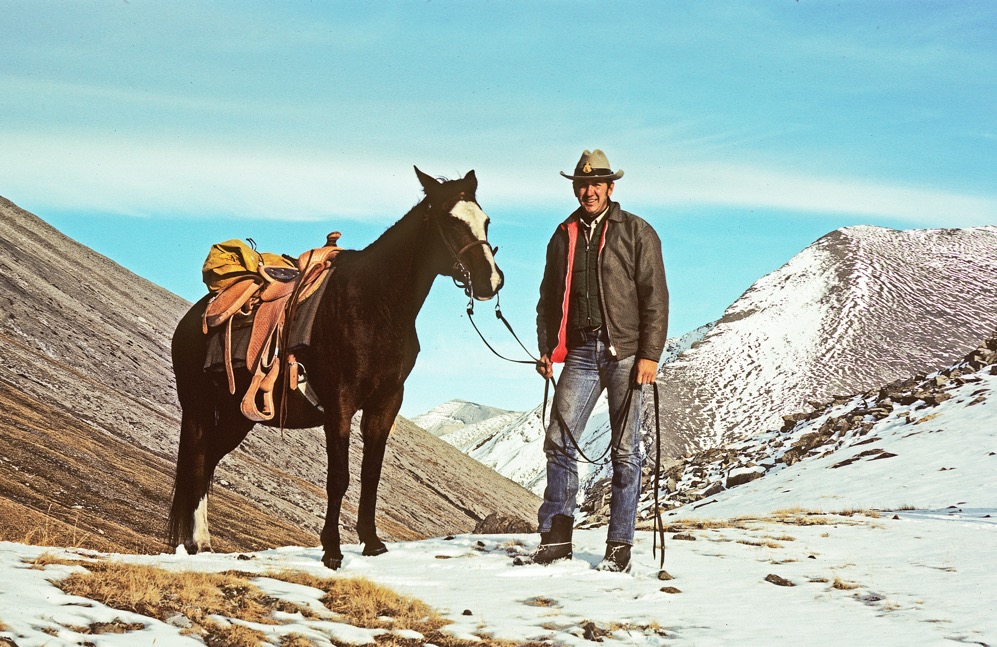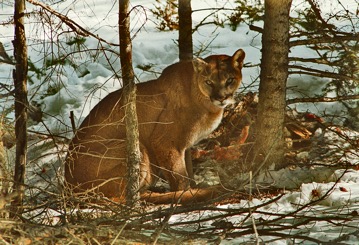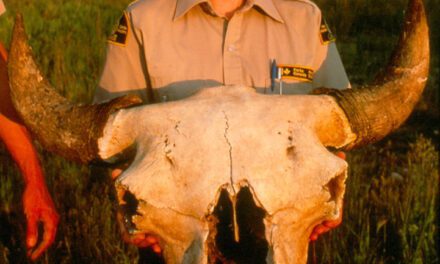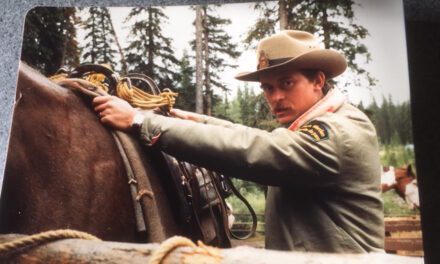MH: How did the Warden Service change over the years? 3410:
HF: The district thing was a big change. The other bad thing was the guy in charge of the union in Banff, pushed for handguns and that never went over well. Remember when RCMP were doing Law Enforcement in the Parks for the Wardens for a year for 10 million dollars. That was silly. And the guy who started it all had a nervous breakdown. And they wanted handguns and the one who has handguns causes more problems. Mentally most of the people are not fit to handle handguns. We had rifles in the pick-up trucks and the backcountry but that was different. Yes, that was one of the bad things.
MH: What about the Warden Service was important to you? 4125:
HF: Protecting and preserving. But even that, the most beautiful lookout at the park at the Columbia Icefields, they let an American company ‘Brewsters’ build the Skywalk, because they gave the government a lot of money so they could build it so what is the point of preserving when Parks themselves give away our land. Completely ridiculous. It looks like hell up there. Lose respect for Parks Canada when they are doing these things. (selling their soul to the highest bidder)
MH: Are there any legends or stories associated with the Warden Service that you can share? 4340:
HF: Bill Peyto is pretty well known legend. Ed Carleton was in the second world war and when he came to Banff, he was hired as a Warden. They sent him up to Bow Summit to the Warden Cabin up there and Dorothy didn’t like the porcupine coming up the seat in the outhouse. So Ed killed all the porcupines in the area and buried them but the quills would be sticking out so he took a lawn mower to cut them down. Not sure if that’s true but it’s funny.
MH: Is there anyone from the Service that stands out in your mind? 4505:
HF: Ed Carleton for sure. He was an interesting guy. It seemed like when I started working in those days, most of the Wardens were cowboys and liked to ride and were not interested in nature at all. And I remember one time, there was an access road onto the railroad track off the 1A and there was a Pileated woodpecker nesting on the access road so I blocked it off and next day I was out there, off duty taking photos, and decided to check on my woodpecker. There was a car parked there with a campfire right under the woodpecker’s nesting hole in a big aspen tree. I went to the Warden Office and asked the guys to go and charge this guy and they wouldn’t, so I went home and put my uniform on and went back and kicked him out.
04645: One time we had a report of a fire on Mount Rundle. We’d had a few thunder/lighting storms so we thought maybe a fire had been ignited by a lightning strike. Ed and I went to investigate and we looked up and couldn’t see any fire but then further down, on Tunnel Mountain, we saw a fire so we thought maybe the reporting person had the wrong location. So we went in there, it was 10-11:00PM and really dark and sure enough, there’s a fire there and here’s this native guy dancing around a fire and a woman laying on a cot. So Ed says, “You go in and I’ll stand here and protect you.” So I go in and ask, “What are you doing here?” and he answers, “I’m having a Sundance, my dad’s ghost is up here and we are going to take over Banff National Park, it’s our land.” I told him, “You’re not allowed to light a fire up here.” Anyways we got the fire out and he packed out the bed down the hill. The thing is, the next day, the Banff Cadets are hiking up Mt. Rundle and found this woman with a broken leg and as it turned out, she had started a fire, burning trees to get some help…so sounds like there had been a fire on Mt Rundle too. We got her out and she survived. Kind of interesting events.
MH: Is there anything about the Warden Service, as you knew it, that you would like future generations to know?4900
HF: Tough questions really. A Warden was a Warden, everybody had a hat. You go down to the states and people working for the parks were nicely dressed and had a hat on, real professionals, but here, only a few people are wardens. So for example, you see a guy doing illegal fishing and you have work in Resource Conservation, you have to wait for a Warden to come down and charge this guy. It has changed now.
MH: What made the Warden Service such a unique organization? 5035
HF: You were here to protect things and you weren’t afraid of going to tell people when they were doing things wrong. I was on boundary patrol a couple of times and it was important to protect the Big Horn Sheep. There was some outfitter hunting on the Park Boundary at Carrot Creek. So Ed and I were up there, we were flown in and we found this thick stand of spruce trees and it was obvious that the (outfitter’s) horses had been there for a few years.
So we were there for several days but never saw the outfitter or horses come in. We saw a hunter. But we made a mistake we were up on a ridge and he could see us standing there so he disappeared quickly out of the Park. That was the thing, you liked to protect animals. A lot of the wardens then, were just cowboys, wouldn’t clear trail, clean the cabin or even talk to people we ran into on the trail…they weren’t trained to be nice to people. I remember one time at Egypt Lake cabin, I went into the shelter to talk to the people and when I left, I was outside and I heard one of the people say, “Wow, that was a nice Warden, he didn’t give us hell for anything.”
‘

Halle on Boundary Patrol, Indianhead
MH: Do you have any lasting memories as a Warden? 5600:
HF: Favorite cabin was at Redearth Cabin by Shadow Lake. You could drive to the cabin and hike into Shadow Lake. Ed and I had fixed it up but some years later they tore the whole thing down and built a new cabin. You couldn’t even sleep in there because the bed was high up and it was so hot when you had a fire going that you would cook. So we were so mad about that. It was a really nice cabin but some wardens complained about it and the cabin was pulled down. There was another good cabin when you went to Indianhead warden cabin by the river and you had to cross the river to get to Indianhead and Peter Fuhrmann blew it up with dynamite…completely ridiculous. You could stay at the cabin if the river was too high and you couldn’t cross with the horses. After they blew it up, there was stuff in the trees. But anyways it was silly stuff like that, there was no direction and people seemed to do what they wanted to do.
MH: Do you ever miss being a Warden? 5830:
HF: Not really when I think about it. I got into some other things working on the Mackenzie Trail and that sort of thing. I think being a warden, if you had your own district, looking after your own stuff. The thing is too, it maybe a little tougher to see, charging people with loose dogs and stuff; and no Wardens wanted to touch it. But I remember, there was one incident at Norquay, a dog was chasing sheep and the Warden there shot the dog. That was really bad you know.
MH: Do you have any photos of yourself as a warden that you would like to donate? Artifacts? HF: provided photos.
MH: What year did you retire? 4648:
HF: 1989. I forgot to tell you about the Elk Study. We had 20 elk radio collared and I had to locate them every 3 days. John Woods was working on his doctorate degree, and we had to collect all the pellets and we flew up in the high country to collect the pellets. We flew along the railroad tracks to look for train kills and to collect all the femur bones from the dead elk so we would land on the track and run out and get the femur bone before the train showed up. And I remember one time we landed beside the railroad track and there was a big bang and we broke the undercarriage of the helicopter. So we lifted up and it was just hanging there and we limped back to Banff and he radioed in for someone to come and build up a platform to land on. And I was thinking we had just come from the high country and it was the next landing that we lost the undercarriage! The study came out that 80% of the elk stayed in the valley and 20% went to the high country. We found that a couple of the cows were missing and they ended up in Assiniboine. It was interesting. The study went for 4 years. John Wood worked for Mount Revelstoke and Glacier National Parks.
MH: What do you enjoy doing in retirement? 10222:
HF: I have written and published several books. My best selling book was, Wildflowers of the Canadian Rockies. It has been updated with new title, Wildflowers of the Rocky Mountains. In 1989, I started my own business, Alpine Book Peddlers, but sold it few years ago to Woodruff and Blum Booksellers in Lake Louise. On my website www.natureinwildplaces.com I have photo gallery showcasing my best pictures and published work. Last year after completing my arctic book, Wild Arctic – The Polar World of the Northern Hemisphere, I am now working on a two-volume book covering Sir Alexander Mackenzie search for the Western Sea, his canoe route from Grand Portage to the Fraser River and his overland trek from the Fraser River to Bella Coola. (Halle, you can add information here about your books if you’d like. And let’s add your website URL as well!)
MH: Is there anything I haven’t asked you that you think I should know about the Warden Service? 4845: HF: No
MH: Anyone else to interview? HF: No MH: Any final comments? HF: No
This interview was conducted by Monique Hunkeler
Monique Hunkeler first started working with Parks Canada in 1989 as Secretary to Banff National Park Finance Manager. She moved into a position as Dispatcher for the Banff Park Warden Service and later worked within Banff National Park and Town of Banff’s IT departments. She is experienced with the interviewing, transcription and archiving process the Park Warden Service Alumni Society.





